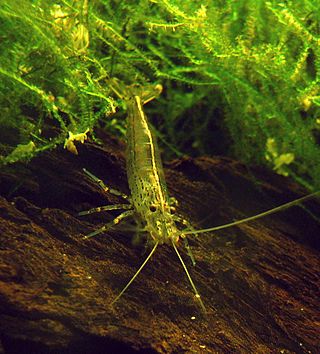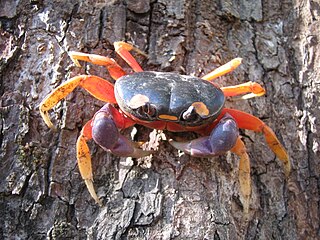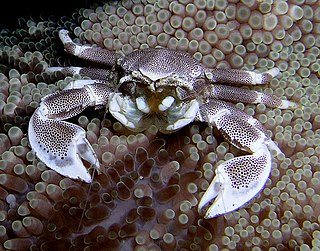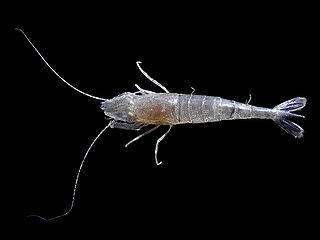
A passerine is any bird of the order Passeriformes, which includes more than half of all bird species. Sometimes known as perching birds, passerines generally have an anisodactyl arrangement of their toes, which facilitates perching.

Crabs are decapod crustaceans of the infraorder Brachyura, which typically have a very short projecting "tail" (abdomen), usually hidden entirely under the thorax. They live in all the world's oceans, in freshwater, and on land, are generally covered with a thick exoskeleton, and have a single pair of pincers. They first appeared during the Jurassic Period.

The Decapoda or decapods are an order of crustaceans within the class Malacostraca, including many familiar groups, including crabs, lobsters, crayfish, shrimp, and prawns. Most decapods are scavengers. The order is estimated to contain nearly 15,000 extant species in around 2,700 genera, with around 3,300 fossil species. Nearly half of these species are crabs, with the shrimp and Anomura including hermit crabs, porcelain crabs, squat lobsters making up the bulk of the remainder. The earliest fossils of the group date to the Devonian.

Atyidae is a family of shrimp, present in all tropical and most temperate waters of the world. Adults of this family are almost always confined to fresh water. This is the only family in the superfamily Atyoidea.

Marta Domínguez Azpeleta is a Spanish former runner and politician. She competes mainly in the steeplechase. She has represented Spain four times at the Olympics and has competed at the World Championships on six occasions.

The Grapsoidea are a superfamily of crabs; they are well known and contain many taxa which are terrestrial (land-living), semiterrestrial, or limnic. Another well-known member with a more conventional lifestyle is the Chinese mitten crab, Eriocheir sinensis.

The Majoidea are a superfamily of crabs which includes the various spider crabs.

Leucosioidea is a superfamily of crabs containing the two families Leucosiidae and Iphiculidae.

Scythrididae is a family of small moths in the superfamily Gelechioidea. The family is sometimes included in the Xyloryctidae as a subfamily Scythridinae, but the Xyloryctidae themselves have sometimes been included in the Oecophoridae as subfamily. Scythrididae adults are smallish to mid-sized moths, which when at rest appear teardrop-shaped.

Gecarcinucoidea is a superfamily of freshwater crabs. Its members have been grouped into families in various ways, with some authors recognizing families such as "Deckeniidae", "Sundathelphusidae", and "Parathelphusidae", but now only the family Gecarcinucidae is currently recognized.
Etyiidae is a prehistoric family of dromiacean crabs only known from Cretaceous and a few Paleocene fossils.

Dromiacea is a group of crabs, ranked as a section. It contains 240 extant and nearly 300 extinct species. Dromiacea is the most basal grouping of Brachyura crabs, diverging the earliest in the evolutionary history, around the Late Triassic or Early Jurassic. Below is a cladogram showing Dromiacea's placement within Brachyura:

Heterotremata is a clade of crabs, comprising those crabs in which the genital openings are on the sternum in females, but on the legs in males. It comprises 68 families in 28 superfamilies.

Cheiragonidae is a small family of crabs, sometimes called helmet crabs, placed in its own superfamily, Cheriagonoidea. It comprises three extant species, Erimacrus isenbeckii, Telmessus acutidens and Telmessus cheiragonus, there are no yet evidences of Cheiragonidae in the fossil record. Many of these crabs were formerly treated as members of the Atelecyclidae.

Goneplacoidea is a superfamily of crabs containing 11 extant families, and two families known only from fossils.
Glaessneropsoidea is a superfamily of fossil crabs. They are found in rocks from Late Jurassic age to Late Cretaceous. The 45 species in the superfamily are divided among 11 genera in four families:
This overview lists proposed changes in the taxonomy of gastropods at the family level and above since 2005, when the taxonomy of the Gastropoda by Bouchet & Rocroi (2005) was published. In other words, these are recent updates in the way various groups of snails and slugs are classified.

The Galatheoidea are a superfamily of decapod crustaceans comprising the porcelain crabs and some squat lobsters. Squat lobsters within the three families of the superfamily Chirostyloidea are not closely related to the squat lobsters within the Galatheoidea. The fossil record of the superfamily extends back to the Middle Jurassic genus Palaeomunidopsis.

Crangonoidea is a superfamily of shrimp containing the two families Crangonidae and Glyphocrangonidae.

Campylonotoidea is a superfamily of shrimp, containing the two families Campylonotidae and Bathypalaemonellidae. Fenner A. Chace considered it to be the sister group to the much larger superfamily Palaemonoidea, with which it shares the absence of endopods on the pereiopods, and the fact that the first pereiopod is thinner than the second. Using molecular phylogenetics, Bracken et al. proposed that Campylonotoidea may be closer to Atyoidea. There are sixteen described species in 3 genera; no fossils are known.


















